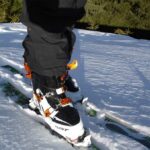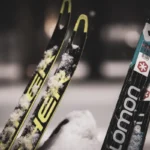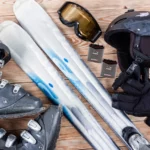A few decades ago, the average all-mountain recreational skis were at least 5-10 cm (2-4 inches) longer than our bodies and the lovely curved, carving edges we now associate with skis didn’t exist. Fast-forward 30 years and those days are firmly over, with ski technology developing at an increasingly fast rate.
Nowadays, the correct ski length depends on a range of factors. These include your height and build, as well as the type of skiing you’re planning to do and your ability as a skier.
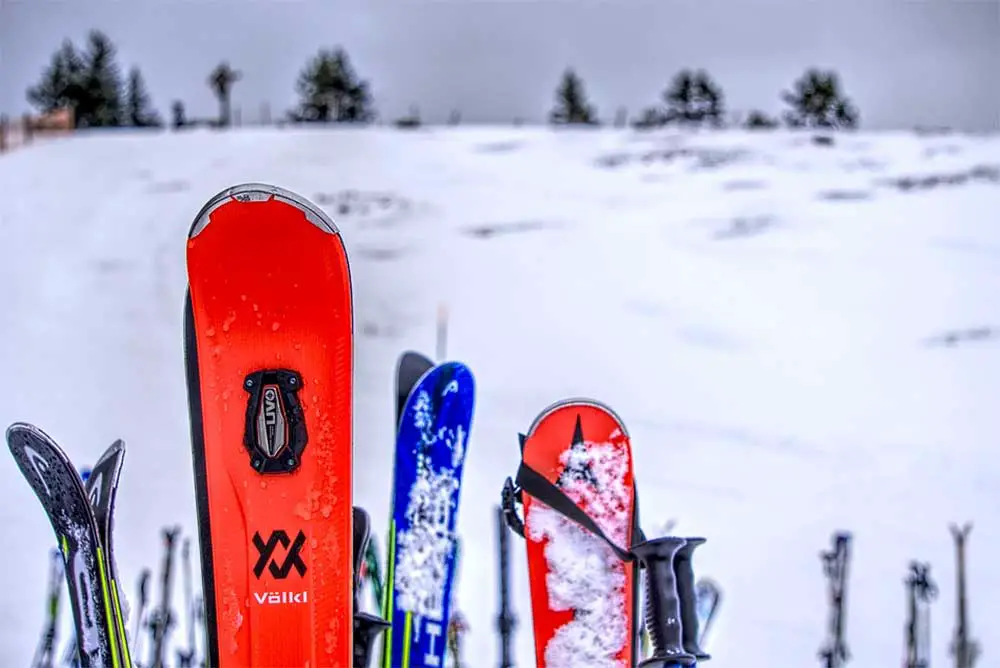
Generally, a beginner or intermediate skier looking for an alpine recreational ski to use on well-groomed slopes should opt for one between chin and eye height. On the other hand, an all-mountain ski for different types of terrain (including off-piste) should be between eye and forehead height.
As you progress in terms of skill and experience on your skis, you’ll probably want to upgrade to longer skis for more speed. This is reflected by the fact that many advanced skiers often choose skis that are full body length or longer.
To help make things a little clearer, this guide will take a closer look at how to make the all-important decision of choosing the correct ski length, including a detailed analysis of ski profiles, as well as an explanation of other determining factors such as ability level, terrain, and body weight.
Type Of Skiing
The best advancement that’s ever been introduced in skiing is the invention of the carving ski. Those beautifully curved edges combined with the significantly shorter ski length (as opposed to earlier skis) have transformed recreational skiing and made turning through the snow a breeze.
Today’s skis are almost always made from top quality materials, so picking a good pair of skis should be reasonably simple right? Well, not so fast. It would be simplifying things a little too much to say, “find yourself a pair of skis that are nose height and get out on the slopes”. There’s more to it.
Before you make your final decision and buy a pair of skis, you should ask yourself, “what type of skiing am I planning to do on these skis?”.
If you’re a beginner or intermediate skier, it’s likely that you’ll spend the majority of your time on nicely groomed slopes. Therefore, you’d be doing yourself a disservice if you went out and bought an expensive pair of freeride skis just to look “the business”.
It’s a much better idea to opt for a pair of skis that accurately reflect your ability level and the type of terrain you’ll be skiing on. With this in mind, it’s useful to think about the ski length you’ll need to choose. We’ll now look to delve into this in more detail.
Ideal Length Of Ski
The first thing to consider when choosing the ideal length of skis is your height. As a typical rule of thumb, a beginner should opt for a ski height close to the chin. This is because shorter skis are usually easier to turn and control, whereas longer skis make these initial turns much more difficult.
Intermediate skiers are best off choosing a pair of skis with a length anywhere between chin height and nose height. Whereas, advanced skiers prefer longer skis that are full body or longer for added speed, stability, and floating ability in some of the off-piste terrain.
This doesn’t mean, however, that shorter skis are restricted just to beginners. They can also be well suited for tricky skiing among trees and on moguls where turns need to be made quickly and sharply.
Listed below you’ll find the recommended ski lengths based on height. Keep in mind that ski lengths are always measured in centimeters, but we’ve also included measurements in feet and inches for your height to make it easier.
Height | Suggested Ski Length (cm) |
|---|---|
122-126 cm (4’0” - 4’1”) | 109-119 |
127-131 cm (4’2” - 4’3”) | 114-124 |
132-136 cm (4’4” - 4’5”) | 119-129 |
137-141 cm (4’6” - 4’7”) | 124-139 |
142-146 cm (4’8” - 4’9”) | 129-144 |
147-151 cm (4’10” - 4’11”) | 134-149 |
152-157 cm (5’0” - 5’1”) | 134-154 |
158-162 cm (5’2” - 5’3”) | 144-164 |
163-167 cm (5’4” - 5’5”) | 159-169 |
168-172 cm (5’6” - 5’7”) | 154-174 |
173-177 cm (5’8” - 5’9”) | 159-179 |
178-182 cm (5’10” - 5’11”) | 164-184 |
183-187 cm (6’0” - 6’1”) | 169-189 |
188-192 cm (6’2” - 6’3”) | 174-194 |
193-197 cm (6’4” - 6’5”) | 179-199 |
> 198 cm (> 6’6”) | 194-209 |
Just be mindful that the recommended sizes above should only be used as a point of departure when deciding on your next pair of skis. You’ll also need to factor in your weight, the terrain you prefer, your ability, your aggressiveness as a skier, and your preferred type of ski profile.
Ski Profile
What exactly is a ski profile? In simple terms, a ski profile is a description of the curvature of the ski when you inspect it from side to side.
There are three main types of ski profiles: camber, rocker, and flat. With a camber profile you’ll find an arch underfoot and a ski that touches the surface near the tip and tail. In contrast, the rocker is the complete opposite, almost banana-shaped, while the flat profile, needless to say, is entirely flat.
These three profiles make up the basic ski profiles. Nevertheless, ski manufacturers are constantly trying to experiment with new combinations of the profiles and tweak them in a variety of ways. For example, you can find a full rocker ski profile with either a long early rise or a shortly early rise.
We’ll now look into each of the three profiles in greater detail, to make sure you get the right pair of skis for your individual needs.
The Camber Ski Profile
The classic camber profile has a slight upwards curve in the middle section of the ski and contact points at either end of the tips. The arch of the ski is forced downward by your body weight, which in turn creates contact with the snow for almost the whole length of the ski (excluding the tip and tail).
The camber profile provides a good amount of stability at higher speeds, as well as an excellent edge hold for smoother turns on groomers. If you place a camber profile ski on a flat surface, the only contact points are the tips of the ski.
Moreover, the arch of the ski being pressed down creates a suspension which helps the ski cut through the snow easier and provide it with more snap. It’s hardly surprising then, that the majority of race skis have a camber profile.
Due to the fact that the camber profile constantly tries to get a solid grip and “dig” into the snow, the chances of the edge getting caught in churned-up conditions is increased. Therefore, it takes a fair amount of effort to turn, considerably more than other ski profiles such as rockered skis.
The Rockered Ski Profile
As opposed to the camber profile, rockered skis tend to float on top of the snow instead.
The rockered profile, also known as the “banana-shape” or “reverse-camber”, is essentially the camber profile turned upside down. The contact points are directly under the skier, while the rest of the skis slightly curve upwards.
Skis with a rockered profile are significantly easier to turn, even in deep snow. This is why they continue to prove incredibly popular with off-piste skiers.
They’re also far more forgiving than the camber profile, which explains why the rockered profile is equally popular among skiers in snow parks who love to experiment with grinding rails and spinning tricks.
The flip side, however, is that skis with rockered profiles aren’t quite as stable when traveling at high speeds. They may absorb the vibrations well, but this can make the tip and tail “springy” on some of the harder groomed surfaces.
The Flat Ski Profile
Yep, you guessed it. The flat ski profile is entirely flat. So, when placed on a flat surface, the entire length of the ski will be in close contact with the surface (obviously except for the front or both ski tips).
Completely flat skis are rare, however, with it being more likely that you’ll find traits of the flat profile combined with other profiles. For example, a popular customized profile is an early rise rocker front, a camber underfoot, and a flat tail.
Profile Combinations
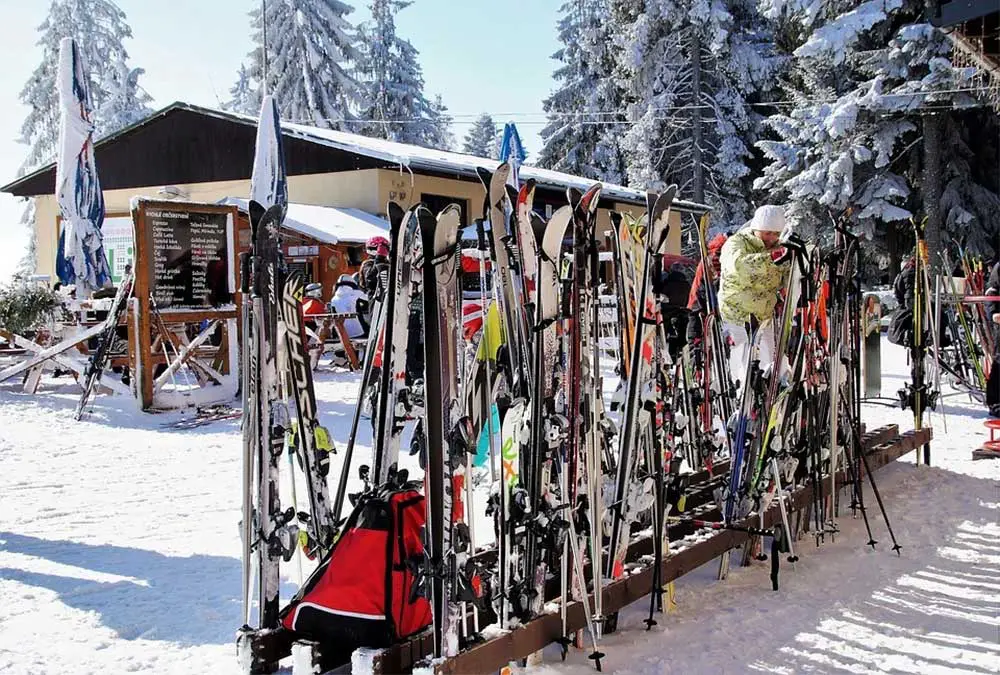
Ski manufacturers continue to experiment with different combinations in the hope that they’ll come across the “perfect” ski for a range of situations. Therefore, it’s becoming increasingly common for the three ski profiles to be combined and tweaked in a number of ways.
This can be confusing at times. For example, two pairs of skis, both with rocker in the front and back, and camber underfoot, can look and behave very differently to the other.
One ski might have a high arch underfoot, while the other may provide an almost flat arch, despite both being described as exhibiting cambered profiles underfoot.
Furthermore, to make matters even more confusing, ski manufacturers also have their own names for each profile combination.
So, what one manufacturer may call a rocker profile at the front of a ski, another may call it a reverse-camber or an early rise profile. Some manufacturers also refer to a full rocker profile as a zero camber, inverted camber, or anti-camber ski.
If you’re not completely bamboozled yet, there’s also the chance of coming across manufacturers who like to combine the function of the ski with their profiles. Take the “powder turn rocker” for example.
We’ll now take a look at some of the most popular profile combinations, but to keep things as simple as possible, we’ll stick to using the terms “rocker”, “camber”, and “flat”.
Rocker-Camber Profile Combination
Skis with a cambered profile throughout and a rockered tip are pretty standard and provided by most manufacturers. The front rocker helps you to float through the snow (even churned-up snow), while the camber profile offers excellent edge hold in turns.
This combination is useful for a leisure and racing ski on firm, groomed surfaces with plenty of power, snap, and edge grip. Just be mindful that it isn’t the most suitable as an all-mountain, off-piste ski however, due to the grip.
Rocker-Camber-Rocker Profile Combination
This particular hybrid is an incredibly versatile ski profile. The rockered tail and tip sections offer excellent flotation in both fresh powder and chopped-up snow, while the camber underfoot is ideal for an effective edge grip on firm groomers.
This type of ski is perfectly-designed for all-mountain skiing, and can be used with equal efficiency on both groomers and off-piste terrain.
It’s worth noting however, the rocker-camber-rocker combination doesn’t offer the same stability as the traditional camber profile so it isn’t as effective as a typical race ski.
Rocker-Flat-Rocker Profile Combination
This profile combination is popular among freeriders. The flat underfoot provides a little more edge hold than the full rocker, while the early rise rocker profile in the tip and tail offer impressive float and sharp turns in deep snow.
Rocker-Camber-Flat Profile Combination
The rocker-camber-flat is a hybrid of all three profiles, and is an efficient all-mountain ski. The rocker tip gives the ski an excellent float through both churned-up snow and fresh powder, as well as any easy turning initiation.
Furthermore, the camber middle provides good edge grip throughout the turns and the flat tail assists the ski in maintaining its high speed.
Body Weight
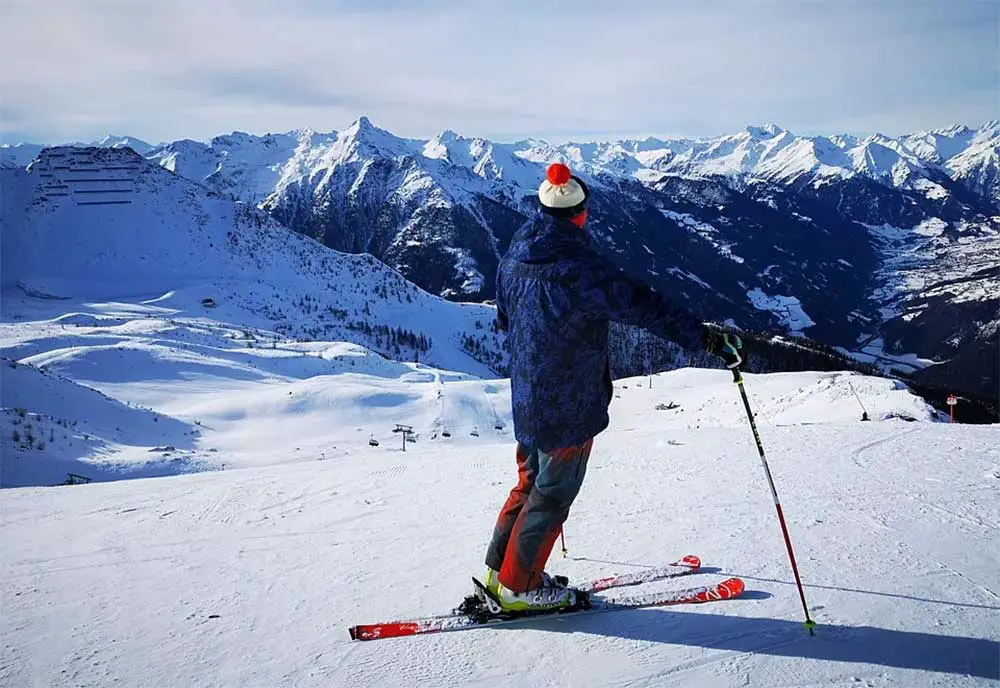
A large number of manufacturers include weight in their size charts, and with good reason! If you’re heavier than the average skier of your height, you may overpower short skis and lose stability. At the other end of the spectrum, if you’re skinnier than the average skier, it’s likely that you’ll find it difficult to control two long skis.
As a result, the general consensus is that heavier skiers (when compared to their height) should opt for a longer and stiffer ski, while skinnier skiers should aim for a shorter ski.
Ability Level
As with all other factors when it comes to choosing the right length in skis, there are no strict, definitive rules - only guidelines. So, listed below are some further recommendations for ski length based on your ability level as a skier.
- Beginner skiers - if you’re just starting out as a skier, you should ideally choose a ski length close to your chin.
- Intermediate skiers - at this level, most skiers prioritize a length between the nose and eyebrows.
- Advanced skiers - the majority of skiers at this level choose skis that are full-body length and bigger.
- Relaxed skiers - if you’re easy going and relaxed with your skiing style, you may decide it’s best to choose skis that are close to your chin - even if you’re at an intermediate level.
- Aggressive skiers - if you’re an intermediate skier with an aggressive style of skiing, and one who isn’t intimidated by steep hills, skis which are slightly longer than average may be your best bet.
Location
Another important thing to ask yourself is, where am I going to ski? This can have a big influence on the length of ski you need.
Are you going to spend the majority of your time on nicely-groomed slopes, off-piste tracks, snow parks, or maybe a little bit of everything?
If you prefer to ski on groomed slopes, a ski length ranging anywhere from your chin to above your head is fine. For all-mountain skiers, a ski which is a bit longer is preferred as this helps you to efficiently float on top of the deep snow.
Now, it’s probably best that you don’t go off-piste skiing as a complete novice, but if you’ve tried a fair bit of skiing beforehand, it may be a fun challenge to try some deeper snow. In this case, look for skis that are full-body length.
Alternatively, you might be the type who prefers to leave the slopes behind and head straight to the snow park. After all, those jumps and rails are great fun! So, if you’re looking for skis for freestyle, you should aim for skis that are at least the same length as your body.
If you find groomers and snow parks aren’t quite the right scene for you, a nice backcountry, off-piste track may be ideal. For terrain such as this, freeride skis are perfect for providing extra buoyancy.
In terms of length, skis that are at least body length (and preferably more) should be targeted. Freeride skis are also wider than the skis typically meant for pistes and come equipped with a rockered profile.
Frequently Asked Questions
Does The Length Of Skis Matter?
As this guide has explained, the length of skis can have a big impact on performance. You’ll want to pick the right length according to your height, weight, skiing ability, and the type of terrain you prefer to ski on.
Without giving these factors their due consideration, you may pick the wrong length of skis and subsequently struggle to control your performance out on the slopes.
Generally speaking, the longer the ski, the greater stability it provides at high speeds, but the tougher it is to turn quickly. Conversely, the shorter the ski, the easier it is to turn sharply and quickly, but its stability at high speeds significantly decreases.
What Happens If Skis Are Too Short?
It’s always important to avoid choosing skis too short for you as this can make it significantly more difficult to turn through the snow. In addition to a lack of control, short skis also suffer from a lack of response or rebound, as well as a failure to fully absorb the vibration when travelling at high speeds.
Does Ski Width Matter?
Width is an extremely important element to get correct when purchasing a pair of skis, and something you need to give a considerable amount of thought to. Skis with a wider waist are great in assisting you to float through the powder. However, be mindful that they do take more work to turn.
The right width, just like height, depends on a number of factors. Perhaps the most important factor to take into account is the terrain where you spend most of your time skiing.
Do Expensive Skis Make A Difference?
While an expensive ski may offer advanced technology and some flashy features, it’s worth noting that they can sometimes be detrimental to a skier’s development - especially beginner and intermediate skiers.
This is because if a ski is “too much” for your ability, it will neither help you improve as a skier nor give you an enjoyable and worthwhile experience.
Yes, you may be able to feel a difference with an expensive ski, but the higher price doesn’t necessarily always translate to guaranteed value for an individual skier.
Concluding Thoughts
Choosing the right ski length is an important decision to make if you want to maximize your performance and enjoyment, whether you prefer to ski on groomed slopes, off-piste, or in snow parks.
There are a number of considerations to take into account, none more so than your height, weight, and ability level as a skier. Furthermore, if you want to pick a perfectly-suited ski, you’ll also need to give some thought to the profile of the ski, as well as the type of terrain you typically ski on.
With all these variables in mind, you should be in a much better position to choose the correct ski length and have complete peace of mind when tearing through the snow.
- How to Train in the Summer for Cross-Country Skiing: Off-Season Strategies for Peak Performance - April 19, 2024
- Ski Lift Ticket Prices in Colorado [For 2024 Season] - January 26, 2024
- How to Choose Classic Cross-Country Skis: A Guide for Beginners - November 10, 2023


